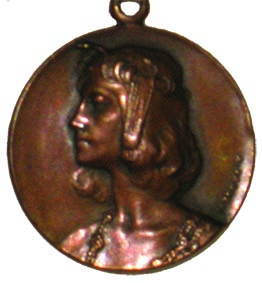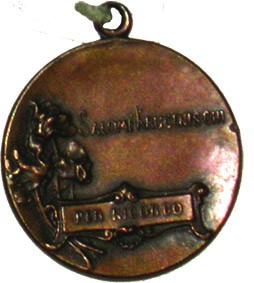While researching the Ukrainian musical culture of the late twentieth and early twenty-first centuries, I discovered a rare medallion dedicated to the outstanding Ukrainian opera singer Solomiya Krushelnytska.
Here is how the Italian press of the time presents the history of the minting of this unique medallion: "At the end of 1905, Solomiya Krushelnytska was about to achieve her next victory on the opera stage - a performance in the Italian premiere of Richard Strauss's opera Salome.
The world premiere of the work took place on December 9, 1905, at the Dresden Court Opera. This opera fascinated, repelled, but left no one indifferent.
A year later, Salome was scheduled to be staged at the La Scala Theater in Milan. The play was prepared by Arturo Toscanini, who invited Solomiya Krushelnytska to play the role of the main character. As it is recalled, the artist prepared the extremely difficult role of Salome so well that Toscanini asked her not to sing during rehearsals (which reached 40) so as not to overwork herself, but to sit on stage and mark the performances of the vocal episodes.
"On December 24, 1905, Salome triumphs at the La Scala Theater in Milan thanks to Toscanini's magic and Krushelnytska's charms," wrote Rinaldo Cartopassi. The singer's performance aroused the unconditional, unanimous admiration of the audience. Guido Marotti recalled: "At the very first performance, she performed the Dance of the Seven Haze by herself, without taking the opportunity to replace her with a professional dancer. It was sensational and a real triumph."
And according to the famous musical and theatrical figure Giulio Gatti-Cazanza, S. Krushelnytska "created an unsurpassed image, much better than all other performers of this role" [1, p. 173-174].
In honor of such a triumphant performance, the Italian sculptor Farnesi engraved a medallion with the singer's profile in this role and the words "Per ricordi," i.e. "In memory" (fig. 1). The medallion was probably made of silver and gold. Two copies of it have been found in the Lviv Historical Museum and the Solomiya Krushelnytska Museum. In addition, on the occasion of the singer's triumphant performance, a commemorative postcard was issued with an image of Solomiya Krushelnytska and a commemorative medallion at the bottom of the postcard.
Among her many awards, in June 1892, young Solomiya received one of the first honors for participating in a competition among the best students of the Conservatory. She performed the aria of Amelia from the opera "La bella masquerade" by G. Verdi. For this performance, the singer was awarded a bronze medal. The medal has not been identified (apparently, it was Austro-Hungarian) [1, p. 12].
July 1, 1892. Solomiya Krushelnytska receives a diploma from the Conservatory of the Galician Music Society, which states: "This diploma is awarded to Ms. Solomiya Krushelnytska as a certificate of artistic education, obtained by exemplary diligence and extraordinary success, especially at the public competition on June 24, 1893, for which she was awarded a silver medal" [1, p. 24]. The medal has not been identified (apparently, it was Austro-Hungarian).
Already in February 1892. Krushelnytska sang as a member of the Lviv Boyan Society, of which she became a member on December 1, 1891. It is highly likely that the "Lviv Boyan" award (fig. 2) belonged to Solomiya Krushelnytska.
During her lifetime, she was recognized as the world's greatest singer. Among her numerous awards and honors, she was named the "Wagnerian prima donna" of the twentieth century. Enrico Caruso, Titta Ruffo, and Fyodor Chaliapin were honored to sing with her on the same stage. The Italian composer Giacomo Puccini presented the singer with a portrait of himself with the inscription "To the most beautiful and charming Butterfly" [2].
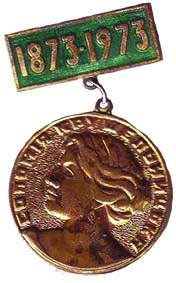
Here are some of the reviews in the newspapers of the time about Solomiya Krushelnytska's performances:
"S. Krushelnytska's tour in Cremona lasted until the end of February. The newspaper "Dilo" on March 10 reported: "Our singer, Ms. Salome Krushelnytska, recently ended the opera season in Cremona with the opera Huguenots, given in her honor at her benefit. Just as our artist enjoyed the great appreciation of the Cremona audience throughout the season, so she received thunderous applause from the enthusiastic audience at her subsequent benefit performance as Valentina. At the end of the performance, the audience showered our artist with flowers. The management and the artistic commission of the Kremenchuk Theater presented the actress with honorary gifts as proof of recognition: two red rings and a branzolete with diamonds." The two rings and the branzoleta with diamonds (a woman's hand ornament) were not found.
The Dilo newspaper of May 5 added: "From the speeches in Dalmatia, it is worth noting a report from the II Dalmata magazine: "Ms. Krushelnytska was the perfect Elvira in the opera Hernani. Her voice is hot, bursting with power, and her technique is brought to perfection. The performance itself is famous and harmonious with the singer's personality. She sang her benefit concert and made it a true triumph for herself. There was no end to the applause, and the stage was transformed into a flower garden of the most beautiful flowers. The evening ended with the presentation of diamonds to the famous artist." The award has not been found.
On March 3, 1897, at the end of Solomiya Krushelnytska's tour, she gave a benefit performance of Verdi's Othello. Reviews of this event can be found in the Lviv newspaper Zorya on April 15: "And yet, perhaps nowhere was she more cordially and heartily remembered and forgiven than in Odesa. There was no end to the ovations given to her by the assembled audience. At the same time, the artist received good gifts: a silver crown with the inscription "To a Talented Artist," a magnificent branzolete with the inscription "To a Glorious Artist from Fellow Countrymen," a silver faceted dinner service, an album with the inscription "To the Perfect Desdemona," not to mention flowers, bouquets, etc. Our countrywoman was accompanied to the railroad yard by our fellow Ukrainians and Russians, Poles and others." The silver crown with the inscription "To the Ideal Desdemona" and the branzolete have not been found.
Afterwards, Maestro Puzzi, who had kindly invited the lady to take part in the celebration, presented her with a large silver medal with gold trim, skillfully made by the Milanese coiner Johnson, on behalf of the Conservatory's Board of Trustees.
In August 1939, the singer visited Galicia and was unable to return to Italy due to the outbreak of World War II. After Western Ukraine was annexed to the USSR in November 1939, the new government nationalized the singer's house, leaving her with only a four-room apartment where she lived with her sister Hanna. During the German occupation of Lviv, Krushelnytska was very poor, so she gave private vocal lessons.
In the postwar period, the singer began working at the Mykola Lysenko Lviv State Conservatory. However, her teaching career almost ended as soon as it began. During the staff purges, she was accused of not having a conservatory diploma, which was later found in the funds of the city's historical museum, as well as a commemorative medallion that is still in the museum's funds.
Living and teaching in Soviet Ukraine, Krushelnytska, despite numerous appeals, was unable to obtain Soviet citizenship for a long time, remaining a citizen of Italy. Finally, after writing an application to transfer her Italian villa and all her property to the Soviet state, she became a citizen of the USSR. The villa was immediately sold, compensating the owner for a tiny fraction of its value [2].
It is highly likely that during the "voluntary" sale of her villa in Italy, the "liberators" looted her property, including her insignia and awards, most of which were made of gold and decorated with diamonds.
Among the first faleristic monuments in Soviet Ukraine in the early 1970s dedicated to Solomiya Krushelnytska were a commemorative medal minted in 1965 and a memorial sign commemorating the 100th anniversary of the famous singer's birth, minted in 1973 by sculptor Luka Bihanych (Fig. 3).
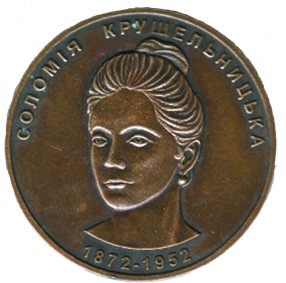
A number of events were dedicated to the 150th anniversary of the birth of Solomiya Amvrosiivna Krushelnytska, a star of the first magnitude of Ukrainian and world culture. And although the war continues to rage in Ukraine, it was decided to mint a medal in honor of this outstanding opera singer through the efforts of Professor Vasyl Gurmak (Fig. 4).
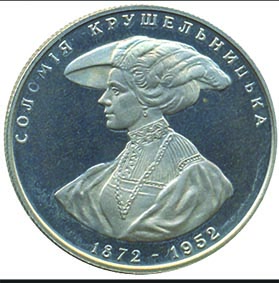
The medal in soft material was transferred to the author's material for detailed elaboration, after which a matrix for serial stamping of medals was made.
The obverse of S. Krushelnytska's medal depicts her portrait with an inscription in a circle: "Solomiya Krushelnytska 1872 - 1952", and the reverse shows the main facade of the Lviv Opera House named after S. Krushelnytska. The portrait of the queen of opera singing and artistry is based on a famous photograph in which the singer's head is turned three-quarters and crowned with a crown.
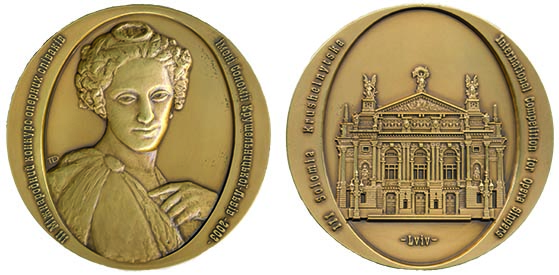
The medal is 40 mm in diameter, made of bronze and brass.
The medal could become a wonderful award for outstanding artists of Ukrainian and world opera.
LIST OF REFERENCES
1. Solomiya Krushelnytska. Chronicle of 1893-1920 - Lviv, 2019.
2. Solomiya Krushelnytska. Chronicle of 1893-1929. - Lviv, 2019.
3. Zagreba M. Ukraine in medallic art. - K.: Logos.
4. Zagreba M. Coins of Ukraine. - K.: 2022.
Below are the awards that are not included in our research, except for the images of Solomiya Krushelnytska.
Solomiya Krushelnytska International Opera Singing Competition. NBU, 2003. Sculptor Roman Tchaikovsky
Badges dedicated to various events
Solomiya Krushelnytska. 135th anniversary of her birth. Ukraine. 2007 Sculptor Viacheslav Popov
Solomiya Krushelnytska. 125th anniversary of her birth. Ukraine. 2 hryvnia 1997.
Solomiya Krushelnytska. 150th anniversary of her birth. Ukraine. 2 hryvnia 2022.

